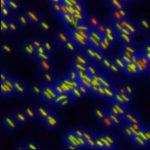Link to Pubmed [PMID] – 17043130
Antimicrob. Agents Chemother. 2006 Dec;50(12):4044-52
The lfrA gene of Mycobacterium smegmatis encodes an efflux pump which mediates resistance to different fluoroquinolones, cationic dyes, and anthracyclines. The deletion of the lfrR gene, coding for a putative repressor and localized upstream of lfrA, increased the lfrA expression. In this study, reverse transcription-PCR experiments showed that the two genes are organized as an operon, and lacZ reporter fusions were used to identify the lfrRA promoter region. The lfrRA promoter assignment was verified by mapping the transcription start site by primer extension. Furthermore, we found that some substrates of the multidrug transporter LfrA, e.g., acriflavine, ethidium bromide, and rhodamine 123, enhance lfrA expression at a detectable level of transcription. LfrR protein was purified from Escherichia coli as a fusion protein with a hexahistidine tag and found to bind specifically to a fragment 143 bp upstream of lfrR by gel shift analysis. Furthermore, acriflavine was able to cause the dissociation of the LfrR from the promoter, thus suggesting that this molecule interacts directly with LfrR, inducing lfrA expression. These results suggest that the LfrR repressor is able to bind to different compounds, which allows induction of LfrA multidrug efflux pump expression in response to these ones. Together, all data suggest that the LfrA pump is tightly regulated and that the repression and induction can be switched about a critical substrate concentration which is toxic for the cell.

